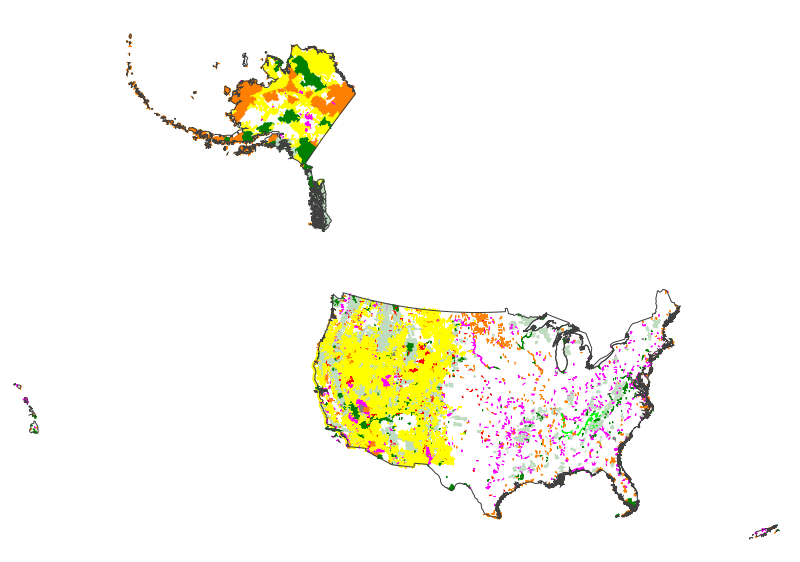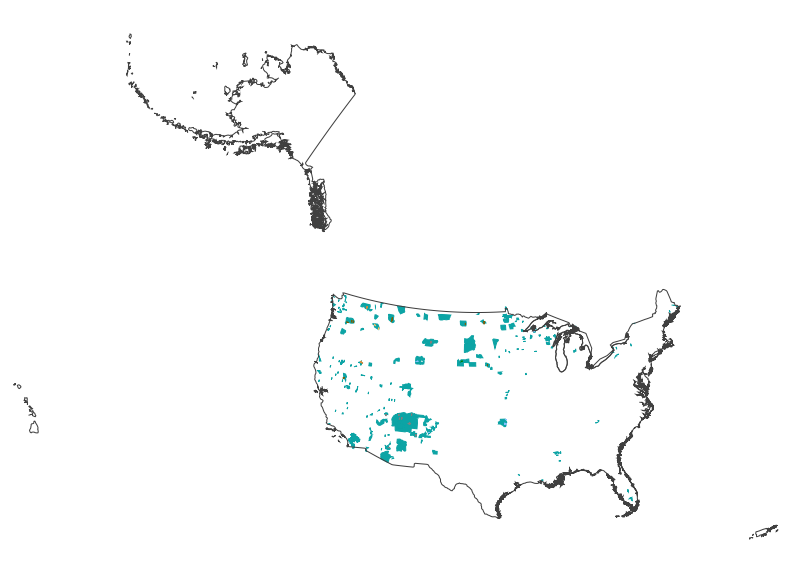Filters: Tags: blm (X)
9,977 results (1.2s)|
Filters
Date Range
Extensions (Less)
Types (Less)
Contacts (Less)
Categories (Less) Tag Types
|
This file contains the polygon SDE Feature Class for Federal Fluid Minerals(Oil and Gas) for the Bureau of Land Management(BLM)Montana/Dakotas. Federal Fluid Minerals as well as Federal Lease status and Indian Minerals/Leases are included. Plat maps are used to find federal mineral ownership and the Bureau of Land Management's LR2000 database is used to find current leasing status.
Categories: Data;
Types: Citation,
Downloadable,
Map Service,
OGC WFS Layer,
OGC WMS Layer,
OGC WMS Service,
Shapefile;
Tags: BLM,
Bureau of Land Management,
boundaries,
energy leasing,
environment,

This map layer consists of federally owned or administered lands of the United States, Puerto Rico, and the U.S. Virgin Islands. For the most part, only areas of 320 acres or more are included; some smaller areas deemed to be important or significant are also included. There may be private inholdings within the boundaries of Federal lands in this map layer. Some established Federal lands which are larger than 320 acres are not included in this map layer, because their boundaries were not available from the owning or administering agency.
Background information.—On July 8, 2012, lightning ignited a fire on Bureau of Land Management-managed land on the Miller Homestead in Harney County, Oregon. High winds combined with unusually hot and dry conditions spread the fire through dry grass and sagebrush and 160,801 acres were burned before the fire was contained on July 24, 2012. In the aftermath, it was determined that ecological restoration was necessary since the majority of the fire occurred within prime habitat for sage-grouse, and the fire had burned with such severity that it removed vegetation down to bare soil. Without rehabilitation efforts, desirable vegetation would be unlikely to reestablish and the site would be open to invasion by noxious...
Categories: Project;
Types: Map Service,
OGC WFS Layer,
OGC WMS Layer,
OGC WMS Service;
Tags: BLM,
Bank stabilization/erosion control,
Bureau of Land Management (BLM),
Fire,
Habitat-based,
The mine permit boundary coverage was created for locational purposes and to aid counties in tax district assessment.
Rights of Way Corridors
Categories: Data;
Types: Downloadable;
Tags: BLM,
Corridors,
Federal Government,
Lands and Realty,
ROW,
The northern leopard frog (Rana pipiens) is a formerly abundant frog that has experienced significant declines across its range and is considered endangered in some parts of the range but still abundant in other parts of the range. Various factors have been invoked to explain population declines in the northern leopard frog, including habitat destruction, diseases, chemical contamination, acidification, increased ultraviolet light due to loss of the ozone layer, introduced predators, overcollecting, climatic changes, and general environmental degradation. However, no one cause has emerged as the primary factor behind population declines in any area. Probably, multiple causes contribute to population...
This theme is polygon data that depicts two types of development for the state of Wyoming. The first is existing development and the second are habitats where there is a high likelihood that development will occur in the near future. We considered development of oil, gas and coal bed methane, mining of minerals (trona, uranimum, coal, and bentonite), urban expansion. Other infrastructure activities such as roads, highways, fiberoptic lines, processing plants, pipelines, other facilities, and various combinations of development that were believed to impact sage-grouse were recorded. Information sources and assessment processes varied depending on data available and resource specialist participation for areas within...
Categories: Data;
Types: Downloadable;
Tags: BLM,
Federal Government,
Wyoming,
biota,
developed habitat,
This page contains links to images of the Public Land Survey System for Wyoming. This information consists of images of all available survey plats for the entire state and approximately 30,000 pages of field notes. The plats are organized by county and then by township and range. The remaining 570,00 pages of field notes are in bound volumes and will not be available for quite some time. Additionally we have now posted all the available images for the Mineral and HES surveys.
Categories: Data;
Types: Static Map Image;
Tags: BLM,
Federal Government,
boundaries,
planningCadastre

This map layer shows Indian lands of the United States. For the most part, only areas of 320 acres or more are included; some smaller areas deemed to be important or significant are also included. Federally-administered lands within a reservation are included for continuity; these may or may not be considered part of the reservation and are simply described with their feature type and the administrating Federal agency. Some established Indian lands which are larger than 320 acres are not included in this map layer because their boundaries were not available from the owning or administering agency.
This dataset is a raster of current predicted suitable bioclimate using statistical correlations between known habitat and current climate (1950-1999 average). 0=Absence; 1=Presence*see Maxent output pdf for details on model parameters.
This dataset is a raster summarizing the change in suitable bioclimate by looking at the difference between current and A2 2050s. Value coding:-3 = Lost bioclimate; 0 = absence (current and future); 1= maintained bioclimate; 4 = gained bioclimate
This data set contains distribution information for all terrestrial and aquatic reptiles, crocodilians, and turtles occurring in the United States and Canada.
This dataset is a raster of current predicted suitable bioclimate using statistical correlations between known habitat and current climate (1950-1999 average). 0=Absence; 1=Presence*see Maxent output pdf for details on model parameters.
This dataset is a raster of current predicted suitable bioclimate using statistical correlations between known habitat and current climate (1950-1999 average). 0=Absence; 1=Presence*see Maxent output pdf for details on model parameters.
This dataset is a raster summarizing the change in suitable bioclimate by looking at the difference between current and A2 2050s. Value coding:-3 = Lost bioclimate; 0 = absence (current and future); 1= maintained bioclimate; 4 = gained bioclimate
Analysis of future ecological integrity to assess the near future (circa 2030) status of the Aquatic Coarse Filter Conservation Elements - Landscape Condition Model Index. Below are the aquatic caurse-filter conservation elements for this indicator: Great Basin Lake / Reservoir Great Basin Spring and Seeps Great Basin Foothill and Lower Montane Riparian Woodland and Shrubland / Stream Rocky Mountain Subalpine-Montane Riparian Woodland and Shrubland / Stream Rocky Mountain Lower Montane-Foothill Riparian Woodland and Shrubland / Stream Inter-Mountain Basins Greasewood Flat Inter-Mountain Basins Wash Inter-Mountain Basins Playa
Scorecard analysis for terrestrial conservation elements and landscape condition. The landscape condition score represents area weighted mean value based upon the combined count and condition score. sum(count*score) / sum(count) *where count equals the cell count and score is the condition value. NatureServe’s ecological integrity framework provides a practical approach to organize criteria and indicators for this purpose (Faber-Langendoen et al. 2006, Unnasch et al. 2008). This framework provides a scorecard for reporting on the ecological status of a given CE within a given location, and if needed, facilitates the aggregation and synthesis of the component results for broader measures of ecological integrity at...
This dataset is a raster summarizing the change in suitable bioclimate by looking at the difference between current and A2 2050s. Value coding:-3 = Lost bioclimate; 0 = absence (current and future); 1= maintained bioclimate; 4 = gained bioclimate
This dataset represents the probability of occurrence for the gypsum soils species assemblage within the Central Great Basin and Mohave Basin Ecoregion. This model represents the composite of multiple cross-validated inductive (Maximum Entropy) models of species distributions using non-spectral landscape variables. Input Variables: Elevation, distance to gypsum soils, soil pH, geology, NatureServe's ecological systems map, available water holding capacity, aspect, and slope. Classification Model: 1 - High Potential Habitat NoData - Very Low Habitat Potential or "Non-Habitat"
This data set contains distribution information for all birds occurring in the Western Hemisphere. The goal of this project is to make this distributional information freely available to the public to inform conservation and other landuse decisions. A Memorandum of Understanding signed by NatureServe (then known as the Association for Biodiversity Information), The Nature Conservancy/Migratory Bird Program, Conservation International/CABS, World Wildlife Fund-US, and in 2000, with the subsequent addition of Environment Canada, governed the initial development and guidelines for sharing of these data. The MOU expired in 2003, but NatureServe, the compiler of the data set, continues to maintain the data largely in...
|

|